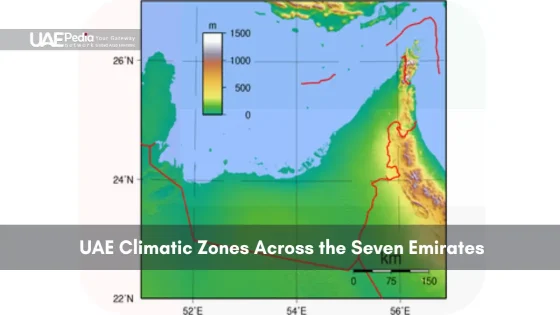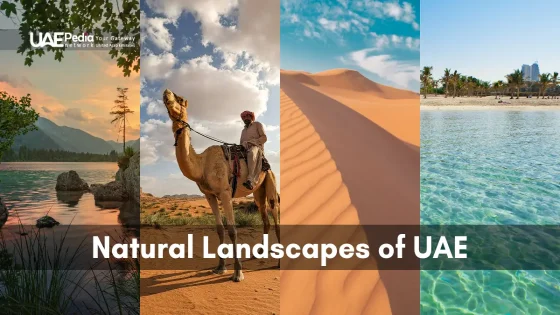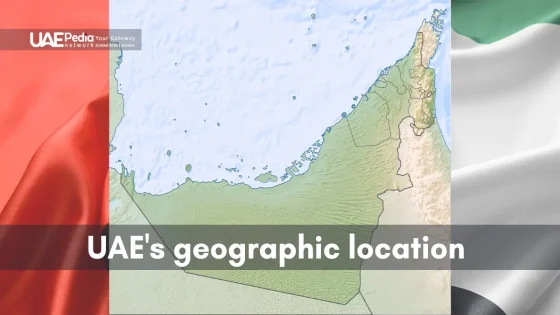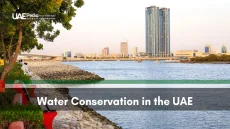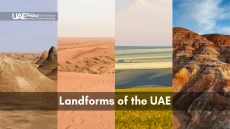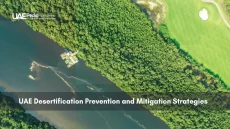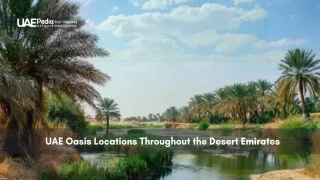Did you know parts of the United Arab Emirates once hit 52°C (125°F) in July? That’s hotter than Death Valley’s average summer highs—a fact confirmed by the Dubai Meteorological Office. Yet this nation isn’t just about scorching sands. Its seven emirates hide surprising weather contrasts, from Abu Dhabi’s breezy coastlines to inland deserts where heat shimmers like a mirage.
Think “desert,” and you’ll miss half the story. Coastal cities battle humidity that turns sea breezes sticky, while mountain towns in the north see rare frosts. Even rainfall varies wildly—some areas get just 70mm annually, yet others experience sudden downpours that flood wadis within minutes. NOAA data shows summer temperatures here climb 15% faster than the global average, making climate literacy essential for residents and travelers alike.
This article unpacks it all. We’ll explore how geography shapes local weather patterns, decode seasonal shifts, and share tips to thrive in each emirate’s unique environment. You’ll walk away with:
- A clear map of regional temperature extremes
- Insider knowledge about managing humidity
- Strategies to plan around sunshine hours
Ready to see the United Arab Emirates through a meteorologist’s eyes? Let’s begin.
Introduction to UAE’s Diverse Climate Landscape
Picture this: coastal humidity so thick you could slice it with a kunafa knife, while just 90 minutes inland, desert winds strip moisture from the air like nature’s dehydrator. This contrast defines the arab emirates’ weather drama—a stage where geography directs every scene.
Where Sand Meets Sea
The united arab’s climate plays tug-of-war between two forces. To the west, the Persian Gulf pumps moisture into cities like abu dhabi, where summer humidity often tops 80%—a statistic that explains why locals cherish their strategies for staying cool. Eastward, the Hajar Mountains steal rainfall from passing clouds, creating microclimates where winter nights occasionally dip below 10°C (50°F).
Nature’s Extremes, Perfected
Three elements shape this dynamic:
- Coastal influence: 700 km of shoreline moderate temperatures but amplify mugginess
- Desert dominance: 80% of landmass acts as a heat amplifier
- Mountain magic: Elevations up to 1,900m create natural air conditioning
Rainfall here plays hard to get—most areas see less than 12 rain days annually. But when winter clouds collide with mountain slopes, sudden downpours transform dry wadis into rushing streams. It’s this unpredictability that keeps both residents and weather apps on their toes.
Ready to explore how these elements create distinct weather personalities across the emirates? Let’s map the surprises.
UAE Climatic zones: A Comprehensive Overview
Imagine packing for a trip where your suitcase needs sunscreen and a light sweater. That’s life in the seven emirates, where climate boundaries shift faster than sand dunes. Let’s decode these weather personalities—nature’s mood rings revealing distinct regional quirks.
Defining the Distinct Zones
In the united arab emirates, three main zones dictate daily forecasts. Coastal strips like abu dhabi bake under 42°C (108°F) summer highs but stay livable thanks to sea breezes. NOAA data shows these areas average 12 hours of daily sunshine in peak months—perfect for beachgoers who don’t mind 70% humidity.
Venture inland, and desert rules apply. Here, summer temperatures spike to 48°C (118°F), yet nights plunge to 20°C (68°F). Rainfall? A rare 70mm yearly treat. Contrast this with northern mountains, where winter lows hit 5°C (41°F) and rain showers gift 140mm annually—enough to spark wildflower blooms.
Why does this matter? Knowing your zone means:
- Picking seasons wisely (coastal winters beat desert summers)
- Preparing for sudden storms in elevated areas
- Timing outdoor activities around temperature swings
Take Al Ain as a desert case study. While just 90 minutes from abu dhabi, its average July high outpaces the coast by 6°C. These microclimates prove geography trumps GPS coordinates every time. Next time you check the weather app, remember—you’re not just tracking climate, you’re navigating nature’s invisible borders.
Seasonal Weather Patterns Across the Emirates
What if your thermostat cycled between “sauna” and “perfect patio weather” every few months? That’s life in the arab emirates, where seasons swing like a pendulum—extreme heat gives way to mild winters, with transitional periods keeping everyone guessing.
When the Sun Takes Center Stage
Summer here isn’t just hot—it’s theatrical. From June to September, coastal temperatures regularly hit 45°C (113°F), while humidity cranks up to 80%. “It’s like wearing a wet blanket,” laughs Dubai resident Amina Al-Mazroui. Dust storms add drama, with recent data showing 5-10 major sand events annually.
Winter’s Cool Counterpoint
December through February brings relief. Daytime highs hover around 24°C (75°F)—ideal for desert camping or rooftop dinners. Northern areas see most of their 100mm yearly rainfall during these months, with 5-7 rainy days on average. Pro tip: Pack layers—mornings can dip to 12°C (54°F).
The shoulder seasons (March-May and October-November) offer Goldilocks weather. Spring sees temperature swings—30°C (86°F) days might plunge 15 degrees by nightfall. Autumn brings calmer winds, though sudden sandstorms still surprise. As meteorologist Dr. Khalid Hassan notes: “Our climate keeps you humble—just when you think you’ve figured it out, the desert laughs.”
These patterns shape daily rhythms. Locals plan outdoor markets and festivals in winter, while summer becomes a time for indoor innovation—like Abu Dhabi’s air-conditioned bus stops. Whether you’re chasing sunshine or storm clouds, understanding these shifts turns weather into an ally rather than an obstacle.
Case Study: Climate Insights from Dubai and Abu Dhabi
Ever tried jogging in soup? That’s how Dubai’s summer humidity feels. Meanwhile, Abu Dhabi’s breeze whispers sweet relief—until dust storms crash the party. These sibling cities share latitude but spar over weather quirks.
Thermometer Tango
Dubai holds bragging rights with a 50.1°C (122°F) record in July 2023. But walk downtown at noon, and glass skyscrapers push that higher. “Our car thermometers hit 55°C (131°F) in Business Bay,” shares resident Layla Al-Mansoori. Abu Dhabi’s urban core stays 2-3°C cooler, thanks to wider spacing and sea winds.
| Metric | Dubai | Abu Dhabi |
|---|---|---|
| July Average High | 42°C (108°F) | 40°C (104°F) |
| Winter Low | 14°C (57°F) | 12°C (54°F) |
| Yearly Rainfall | 94mm | 62mm |
| Summer Humidity | 85% peak | 75% peak |
When Skies Throw Tantrums
March 2024’s sandstorm painted both cities orange. Dubai’s Burj Khalifa vanished like a magic trick. But thunderstorms? Abu Dhabi wins there—last December’s downpour flooded Al Maryah Island’s tunnels in 90 minutes.
Pro tip: Follow the arab emirates’ weather alerts. When humidity hits 80%, locals hit malls. Sandstorm prep? Seal windows with tape—a trick learned after 2021’s “Red Wednesday” storm coated cars in grit.
Regional Variations Across the Seven Emirates
Think seven siblings raised under one roof—each emirate developed its own weather personality. Coastal Ras Al Khaimah whispers salty breezes while desert-bound Al Ain bakes like a clay oven. These microclimates prove size doesn’t matter when geography plays favorites.
Temperature, Precipitation, and Sunshine Differentials
Let’s crunch numbers. Fujairah’s mountain-backed coast sees 160mm annual rainfall—double Abu Dhabi’s tally. Summer highs tell another story:
| Location | July Avg (°C) | Jan Low (°C) | Yearly Sun (hours) |
|---|---|---|---|
| Fujairah Coast | 38 | 16 | 3,100 |
| Al Ain Desert | 45 | 12 | 3,400 |
| Abu Dhabi City | 41 | 14 | 3,250 |
Why such swings? Coastal cities get free AC from sea breezes—but pay with 80% summer humidity. Inland areas trade mugginess for oven-like dryness. Urban jungles like Dubai trap heat, creating “concrete islands” 5°C warmer than nearby dunes.
Rain dances to its own rhythm here. Sharjah’s 2023 downpour flooded streets with 90mm in two hours—more than its usual annual quota. Meanwhile, Liwa Oasis might wait years for a proper shower. “Our weather keeps meteorologists humble,” chuckles forecaster Amal Khalid from the National Centre of Meteorology.
Smart travelers play zone-hopping:
- Coastal winters (Nov-Mar) = beach bliss
- Mountain springs (Feb-Apr) = wildflower hikes
- Desert autumns (Oct-Nov) = stargazing nights
Pack sunglasses for RAK’s 3,400 annual sunshine hours—or an umbrella for Fujairah’s surprise mountain showers. In the arab emirates, your perfect climate is always one emirate away.
Comparative Analysis: UAE Climate Versus the Broader Middle East
While Dubai’s beaches sizzle, Lebanon’s mountains offer ski slopes—welcome to the Middle East’s climate kaleidoscope. The arab emirates sit at a crossroads where desert heat tangoes with coastal humidity and rare mountain chills. Let’s unpack how this compares to neighboring regions.
Arid, Semi-Arid, and Mediterranean Influences
Three climate types dominate the region. The united arab emirates shares Saudi Arabia’s arid core—both average 100mm yearly rainfall. But coastal cities like abu dhabi add 70% summer humidity, while Riyadh’s inland desert stays bone-dry. Head northwest, and Mediterranean vibes emerge: Beirut enjoys 800mm annual rain and 24°C (75°F) summer temperatures.
| Location | Summer Avg | Yearly Rain | Sunshine Hours |
|---|---|---|---|
| Dubai, UAE | 41°C (106°F) | 94mm | 3,400 |
| Riyadh, Saudi | 43°C (109°F) | 100mm | 3,200 |
| Baghdad, Iraq | 45°C (113°F) | 150mm | 3,000 |
| Sana’a, Yemen | 30°C (86°F) | 200mm | 2,900 |
Geography explains these gaps. Coastal breezes cool arab emirates cities, while Iraq’s Tigris-Euphrates basin traps heat. Yemen’s highlands steal moisture from monsoons—a perk the Hajar Mountains mimic on smaller scale.
Cultural adaptations vary wildly. UAE malls thrive in summer, while Oman’s Dhofar region celebrates khareef (monsoon) festivals. Saudi’s date farms rely on ancient irrigation, contrasting Lebanon’s vineyards that need no extra water.
Travel smart: Coastal winters here beat Jordan’s frosty Petra nights. Summer in Muscat? Swap for average 28°C (82°F) days in Turkey’s Mediterranean coast. Every region has its sweet spot—you just need the climate decoder ring.
Impacts of Climate Change on Emirates’ Weather Dynamics
The desert’s heartbeat is racing—July 2023’s 52.2°C (126°F) in Sweihan wasn’t just a record-breaker. It signaled a shift in the arab emirates’ climate rhythm. From erratic rain bursts to nighttime highs that won’t quit, traditional weather patterns are rewriting themselves.
Adapting to Rising Temperatures and Changing Rainfall Patterns
Data tells the story: summer temperatures now climb 15% faster than global averages. March 2024 saw Dubai’s heaviest single-day precipitation in 75 years—submerging highways with 128mm downpour. Meanwhile, Abu Dhabi’s groundwater salinity spiked 40% since 2020, challenging date farmers.
Communities aren’t waiting. The government’s climate adaptation strategy combines tech and tradition:
- AI-powered cloud seeding boosted rainfall by 35% in 2023 trials
- Shade structures now cover 82% of public parks
- Ancient falaj irrigation systems revived for modern farms
Tourism faces heat too—literally. Resorts now offer “coolcation” packages with sunset desert tours replacing midday safaris. Farmers in Al Ain experiment with drought-resistant quinoa crops, while architects design buildings mimicking termite mounds’ natural cooling.
“We’re not just surviving the change—we’re learning to dance with it,” says environmental scientist Dr. Noora Al-Mansoori. With 60% of the united arab’s water now coming from desalination plants, innovation becomes the new oasis. Every adapted day proves awareness fuels action—and action builds resilience.
Final Reflections on UAE Climate Dynamics and Future Trends
Navigating the Arab Emirates’ weather is like flipping through TV channels—coastal mugginess, desert scorchers, and mountain chills all play lead roles. From Abu Dhabi’s 85% summer humidity to Al Ain’s 45°C (113°F) peaks, this land thrives on contrasts. Winters gift 24°C (75°F) days perfect for dune drives, while northern regions surprise with rare frosts.
Climate shifts are rewriting the script. Last year saw rainfall extremes—Dubai’s 128mm downpour in March contrasted with Liwa’s 70mm annual average. Rising temperatures now climb 15% faster than global trends, pushing innovations from cloud-seeding tech to ancient irrigation revivals.
Smart planning turns weather into an ally. Coastal escapes shine in winter, desert adventures thrive at dawn, and mountain trails beckon after rare rains. Bookmark real-time alerts and respect nature’s rhythm—it’s the key to thriving here.
Curious about tomorrow’s forecast in the United Arab Emirates? Dive deeper into hyperlocal insights at UAEPedia.net, where every cloud—sandstorm or rainburst—tells a story. The road ahead holds challenges, but also ingenuity blooming like desert flowers after a shower.
While all three share desert landscapes, the UAE’s coastal position brings higher humidity and occasional fog—especially in Abu Dhabi and Dubai. The Hajar Mountains also create microclimates with cooler temps and rare rainfall bursts you won’t find in flatter regions.
Absolutely! December-February nights can dip to 12°C (54°F) in desert areas—perfect for bonfires under starry skies. Pack layers for dawn desert safaris or mountain hikes, though midday still feels pleasantly warm.
Summer shamal winds sometimes whip up dramatic dust clouds, reducing visibility. Flights rarely cancel, but outdoor activities might pause temporarily. Pro tip: Keep sunglasses handy and check local weather apps for real-time updates.
Ras Al Khaimah’s mountain valleys steal the show here, catching occasional winter showers that turn wadis green. The east coast near Fujairah also gets more precipitation than Dubai’s skyscraper-lined shores.
A> Head uphill! Jebel Jais in Ras Al Khaimah sits 1,900 meters above sea level, offering temps 10°C cooler than Dubai. Even in August, early mornings here feel like nature’s air conditioning.
Rising sea levels push innovation in coastal construction, while temperature spikes drive smart city initiatives. You’ll see solar-powered bus stops, fog-harvesting tech, and urban parks designed as natural cool zones—future-proofing the desert lifestyle.
